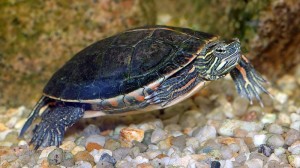SATURDAY, 23 JULY 2011
The morphology of fossils and living animals has been used in the past to look at the evolution of and relationship between different species, but for turtles this has led to some confusion [1]. Most reptiles belong to the group called Diapsida, which are characterised by temporal fenestrae, two holes in the skull that carry muscles attaching to the jaw. Turtles however lack these fenestrae. This has led to them being put in their own category between amphibians and other reptiles as they appear to be related to primitive reptiles that pre-date diapsids.An alternative hypothesis states that the ancestors of turtles used to have temporal fenestrae but lost them during evolution. A recent genetic comparison between a painted turtle Chrysemys picta bellii, a lizard and an alligator suggests that this is indeed the case [2]. The study was based on microRNA, short stretches of nucleic acids that are particularly useful in phylogenetic analysis as they may be gained over time but once introduced are rarely lost. Turtles are now considered to be closely related to snakes and lizards, which have a more recent common ancestor than the rest of the diapsids.
Written by Sarah Gardner

